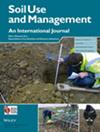长期秸秆覆盖可减轻微生物的养分限制,提高集料内部的碳利用效率
IF 3.7
3区 农林科学
Q1 SOIL SCIENCE
引用次数: 0
摘要
众所周知,长期秸秆覆盖会改变土壤养分含量、聚集分布和细胞外酶活性。然而,长期秸秆覆盖对微生物养分限制和聚集体内碳利用效率(CUEst)的影响仍不清楚。为了填补这一空白,我们在半干旱地区进行了为期 10 年的田间试验,并使用生态酶化学计量学模型来量化长期覆盖下土壤团聚体中微生物的资源限制。我们研究了两种覆盖措施(塑料薄膜覆盖[FM]和秸秆覆盖[SM],无覆盖为对照[CK])对土壤团聚体养分含量和限制的影响。结果表明,与塑料薄膜覆盖相比,秸秆覆盖增加了 2 毫米以上聚合体的比例,降低了 2-0.25 毫米级别聚合体的比例。此外,调频法导致土壤中碳(C)和磷(P)的限制,尤其是在 2 毫米级,而微调法则减轻了这些限制。这种影响主要归因于土壤有机碳(SOC)和微生物生物量碳含量(Cm)的增加,特别是与较大的聚合体(>2 mm)相关的碳含量的增加以及碳氮(C-N)获取酶活性的增加。SM还通过影响微生物的P限制而导致高CUEst。随机森林分析表明,土壤非生物因素,尤其是 SOC 和全氮(TN),是导致微生物资源受限的主要因素。这些研究结果表明,覆盖材料决定了土壤团聚体的发展以及这些团聚体内的资源分配。因此,这项研究为半干旱地区制定有效的碳管理战略提供了宝贵的见解。本文章由计算机程序翻译,如有差异,请以英文原文为准。
Long‐term straw mulching alleviates microbial nutrient limitations and increases carbon‐use efficiency within aggregates
Long‐term straw mulching was known to change soil nutrient content, aggregate distribution and extracellular enzyme activities. However, the impact of long‐term straw mulching on microbial nutrient limitations and carbon‐use efficiency (CUEst ) within aggregates remains unclear. To fill the gap, we conducted a 10‐year field experiment in a semi‐arid region and used an ecoenzymatic stoichiometry model to quantify microbial resource limitations in soil aggregates under long‐term mulching. We studied the effects of two mulching measures (plastic film mulching [FM] and straw mulching [SM], with no mulching as the control [CK]) on the nutrient content and limitations within aggregates. The results show that compared with FM, SM increased the proportion of aggregates to larger >2 mm and decreased the proportion of aggregates in the 2–0.25 mm classes. Additionally, FM resulted in carbon (C) and phosphorus (P) limitations in the soil, particularly in the >2 mm class, while SM alleviated these constraints. This effect was primarily attributed to the increase in soil organic carbon (SOC) and microbial biomass carbon content (Cm ), especially the enhanced carbon content associated with larger aggregates (>2 mm) and the increased activities of carbon–nitrogen (C–N)‐acquiring enzymes. SM also resulted in high CUEst by influencing microbial P limitation. Random forest analysis indicates that soil abiotic factors, particularly SOC and total nitrogen (TN), were the main drivers of microbial resource limitations within the aggregates. These findings suggest that the mulching material determines the development of soil aggregates and resource allocation within these aggregates. Thus, the study provides valuable insights for formulating effective carbon management strategies in semi‐arid regions.
求助全文
通过发布文献求助,成功后即可免费获取论文全文。
去求助
来源期刊

Soil Use and Management
农林科学-土壤科学
CiteScore
7.70
自引率
13.20%
发文量
78
审稿时长
3 months
期刊介绍:
Soil Use and Management publishes in soil science, earth and environmental science, agricultural science, and engineering fields. The submitted papers should consider the underlying mechanisms governing the natural and anthropogenic processes which affect soil systems, and should inform policy makers and/or practitioners on the sustainable use and management of soil resources. Interdisciplinary studies, e.g. linking soil with climate change, biodiversity, global health, and the UN’s sustainable development goals, with strong novelty, wide implications, and unexpected outcomes are welcomed.
 求助内容:
求助内容: 应助结果提醒方式:
应助结果提醒方式:


